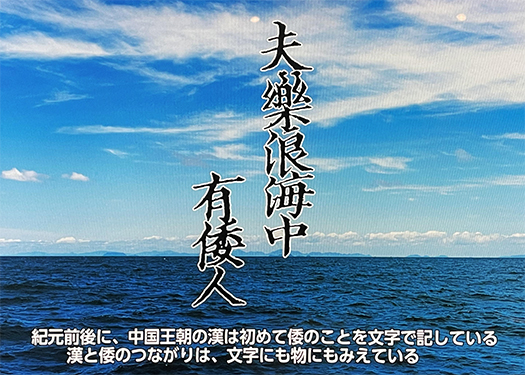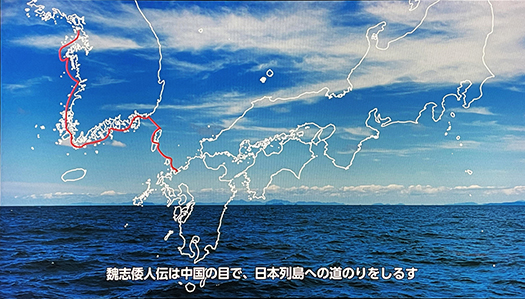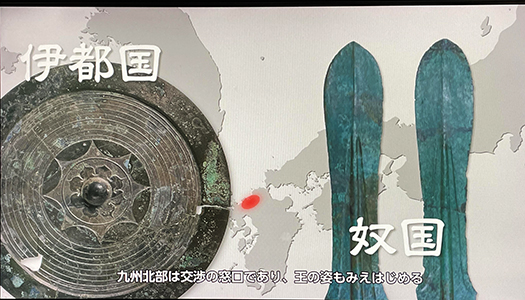


きのう皇學館大学・岡田登名誉教授の説をご紹介しました。
日本政治の初源期においての最大のポイントが「外交」であったという考え。
経済としての日本社会の発展は弥生の水田農耕が列島に拡散していったことで
その農耕最適地がどんどん東進していった。
九州南部は独特の土壌地質であって、水田農耕としては瀬戸内海地域から
さらに畿内地域、東海・北陸と経済社会拡大が進展していった。
アジアからの旺盛な移民流入もあったに違いない。
ことは食糧にかかわることなので当然人口爆発ということと同義だった。
そういう社会環境の進展の中で祭政として方向性を領導する支配層は
中国社会が国家を生成させることで発展の加速力を得ていることを
交渉・交易の過程で強烈に体験させられただろうと思う。
漢は鉄という産業の最重要ポイントを「国家管理」することで
社会発展をこれみよがしに周辺の社会に強く認識させていった。
漢字という共通コミュニケーション手段をも創造し、
社会コントロール方法としての「政治支配」構造をつくり出していた。
こういった「外圧」があったときに歴史年代の日本社会がどう対応したか。
直近では明治の開国、そして戦後の社会変動を見れば、
日本の選択というのは一択だった可能性がもっとも高い。
そういう「外圧」をむしろ積極的にテコにして社会進化を進める。
統一国家というものの強烈な「有用性」を目の当たりにすれば
それを積極的に導入し「学んで」咀嚼していくのが列島人社会の特質。
明治国家、戦後国家がたどったと同じ内容のことが最初期体験として
この段階で生起したと考える方がはるかに妥当だと思える。
日本社会でもその地理的な要素から農業発展には濃度の違いが生まれ
各地域で「八百万」の支配構造が自然に生成されていただろうけれど、
その各指導層としては経済で根幹的に重要な鉄の確保が
中国国家によって左右される現実の中で、それへの対応を常に迫られていた。
各地域間の覇権同士では競合関係もあっただろうし、
それらの「合従連衡」関係も進展していったに違いない。
出雲王権とはこういうゆるやかな連合関係の存在だったか。
そういうなかで「神武東征」という「日本」国家の起動要因が生成した。
こういった「大状況把握」がふさわしいとわたしには思えます。
そして「統一政権国家」というものの実効性を考えれば
対外的な文化導入地域としては北部九州が適地だとはいえ、
政権の列島支配のバランスを考えれば「東征」に蓋然性がある。
この時代の、そしてそれ以降の社会の構図として
畿内地域が中央政府所在地としてはもっとも妥当だったのだろう。
最終的に奈良平野地域が選択されたのには、独自の条件もあっただろう。
この要因分析とその後の社会発展に於いてこの選択が日本人と国家にとって
最適解であったかどうかは検証の余地があるだろう。
一方で奈良平野が選択されたことで生じた社会経済文化的な特異要因も
大いに検証されていく必要があると思う。こっちの方が興味深いか(笑)。
English version⬇
The Creation of a Nation = Economic Development and the Jimmu Expedition to the East 37,000 Years of the Japanese Archipelago – 40]
Eastward expansion of rice paddy farming throughout Japan. The economic and social development by the establishment of the Chinese state was seen on the side. The probability of the Jinmu expedition and the creation of a nation increased.
Yesterday I introduced a theory by Professor Emeritus Noboru Okada of Kōgakukan University.
He believes that diplomacy was the most important factor in the early period of Japanese politics.
The development of Japanese society as an economy was the result of the spread of Yayoi rice paddy farming across the archipelago.
The optimum land for agriculture moved eastward.
Southern Kyushu has a unique soil geology, and paddy field agriculture was developed in the Seto Inland Sea region, the Kinai region, the Tokai region, the Tokai region, and the Tokai and Tokai regions.
The economic and social expansion of the region continued to progress from the Seto Inland Sea region to the Kinai region, and then to the Tokai and Hokuriku regions.
There must have been a strong influx of immigrants from Asia.
The population explosion was naturally synonymous with the food shortage.
In such an evolving social environment, the ruling class, which guided the direction of the government as a ceremonial regime, had the responsibility to ensure that Chinese society would be able to generate a nation.
Chinese society was gaining an acceleration of development through the creation of the state.
The Han Dynasty was the most important industrial power in the iron industry, and it was the most important industry in China.
By “state controlling” the most important point of industry, iron, the Han
The Han Dynasty, by “state control” of the most important point of its iron industry, made the surrounding societies aware of its social development.
The Han also created a common means of communication in the form of Chinese characters
This was a way to control society and create a structure of “political domination”.
How did Japanese society in the historical period respond to such “external pressure”?
Looking at the most recent period, the opening of Japan to the outside world in the Meiji era, and the social changes that occurred after the war, it is clear that Japan had only one choice.
It is most likely that Japan had only one choice.
Japan’s social evolution was driven by such “external pressure” rather than by its own positive leverage.
If we see the strong “usefulness” of a unified nation, we will actively introduce and “learn” it.
The characteristic of the archipelagic societies is that they actively introduce, “learn,” and chew it up.
It is much more likely that the same thing that happened to the Meiji and postwar nations
It is far more plausible to think that the same thing that happened to the Meiji and postwar states occurred at this stage of their initial experience.
Even in Japanese society, the geographical factors created differences in the concentration of agricultural development.
The “eight million” ruling structure would have been naturally generated in each region, but the leaders would have been more concerned with the economy.
However, the reality is that the Chinese state is in charge of securing iron, which is fundamentally important for the economy.
The leaders of each of these regions had to deal with the reality that the Chinese nation was in control of the availability of iron, which was fundamentally important to their economies.
There may have been competition among regional hegemons.
The Izumo kingdom was not a loose, united entity, but a “combination” of the two.
The Izumo royalty may have existed in such a loose federative relationship.
It was in such a situation that the “Jimmu expedition” was the starting factor of the “Japanese” state.
I believe that this kind of “grasp of the larger situation” is appropriate.
And if we consider the effectiveness of the “unified government state
Although northern Kyushu was the best place to introduce Japanese culture to the outside world, it was not the best place to introduce Japanese culture to the Japanese people.
However, the balance of the regime’s control over the archipelago makes the “Eastern Expedition” more probable.
The composition of society in this period and beyond
The Kinai region was probably the most appropriate location for the central government.
The final choice of the Nara Plain region may have had its own unique conditions.
In analyzing these factors and the subsequent social development, it is important to examine whether this choice was the optimal solution for the Japanese people and the nation.
There is room to verify whether this choice was the best solution for the Japanese people and the nation in the analysis of these factors and the subsequent development of society.
On the other hand, the socioeconomic and cultural peculiarities that resulted from the selection of the Nara Plain also need to be examined.
I think it is necessary to examine the socioeconomic and cultural peculiarities that resulted from the selection of the Nara Plain. This is more interesting (laugh).
Posted on 12月 10th, 2022 by 三木 奎吾
Filed under: 日本社会・文化研究, 歴史探訪







コメントを投稿
「※誹謗中傷や、悪意のある書き込み、営利目的などのコメントを防ぐために、投稿された全てのコメントは一時的に保留されますのでご了承ください。」
You must be logged in to post a comment.